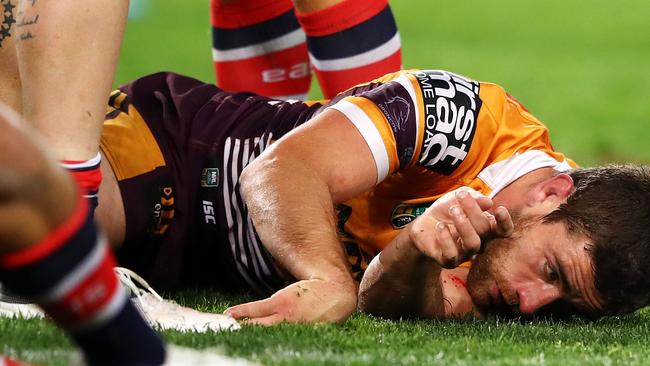Forget the debate over the NRL’s charge; Dylan Napa’s head clash technique is ugly and dangerous
MUHAMMAD Ali never got knocked out but he knew what concussion felt like. And we all witnessed its effects on the champ. That’s why tackles like Dylan Napa’s are so dangerous, writes PAUL KENT.

Opinion
Don't miss out on the headlines from Opinion. Followed categories will be added to My News.
MUHAMMAD Ali never got knocked out in his career. He never had to play the Roosters, though.
Joe Frazier knocked Ali down in their first fight at Madison Square Garden. Ali rose and took the count and lost the fight on points. Three others put him down, only for him to rise each time and win.
Ali understood what a concussion looked like, though. He described it as the “half-dream room”.
MONDAY BUNKER: Has Barrett blundered?
FINALS FORM: Collective slump means anyone can win

“A heavy blow takes you to the door of this room,” he wrote in his autobiography.
“It opens, and you see neon, orange and green lights blinking. You see bats blowing trumpets, alligators play trombones, and snakes are screaming. Weird masks and actors’ clothes hang on the wall.
“The first time the blow sends you there, you panic and run, but when you wake up you say, ‘Well, since it was only a dream, why didn’t I play it cool …’”
Ali never wanted to panic and run.
So he practised for the half-dream room. He let sparring partners hit him and concuss him in sparring and then practised defending himself, with the neon lights blinking and the bats blowing trumpets, to avoid the final blow.

“You have to fix it in your mind and plan to do it long before the half-dream comes …” he said.
“The blow makes your mind vibrate like a tuning fork. You can’t let your opponent follow up. You got to stop the fork from vibrating.”
The tuning fork eventually vibrated all the way through Ali’s brain.
He never got knocked out but there were signs of brain damage, later identified as Parkinson’s Syndrome, already when he fought Larry Holmes at age 38.
From his 30s to 40s his speech slowed by 26 per cent, according to medical experts, when it should not have slowed at all and within 10 years Ali was boxing’s tragedy, its most youthful personality grown old before his time.

In much of the research into concussion syndrome in the NFL the damage is believed to be caused not by fully concussive blows but by what they call “micro-concussions”.
The small blows, when white lights pop in your head, of helmet to helmet contact in scrimmages. There are dozens in every game, hundreds over a training week.
Not unlike the rugby league tackle.
Dylan Napa took the early guilty plea for his knockout tackle on Andrew McCullough.

Napa knocked McCullough unconscious in Saturday night’s loss to Brisbane. He was charged the following day and on Monday took the early plea.
Solid debate has divided the game from whether Napa should have got charged at all to whether the three-week suspension was too lenient.
Napa escaped a charge earlier this season when he hit Korbin Sims in a similar tackle. It broke Sims’ jaw.
The NRL changed the rule interpretation after that round. It enabled them to charge Napa after Saturday night.
The Roosters considered fighting the charge but had no clear definition of guilt. The new interpretation has not been tested.
Just a few weeks back another player in another game had a similar head contact for no charge. It adds to their confusion.
All that was certain was if they challenged they risked losing Napa possibly for the grand final.

The Roosters immediate concern over Napa’s tackling style is availability. There are long-term decisions to be made, though.
Several NRL players in the past, and notably one player now, were known for using their head as a weapon in tackles.
Positioned correctly the effect is devastating. A concussion, one less player in the rotation and a whole lot of swagger for the defending team.
It seems barbaric to suggest it happens, but it happened and still happens. And for the same reason the headbutt is effective in a street fight.
The Roosters insist Napa is not among them, even after his second tackle this season.
But they cannot avoid the possible long-term health risks Napa’s tackles might cause.
It is no point warning Napa. He is the modern warrior. And a young man. Long term health is for another day.
Ali once believed the same.

The difference is he did not know then what we know now.
For every collision we wince at there might be dozen more where Napa suffered a micro-concussion. In the old days, he had his bell rung.
What are the long term consequences?
The head clash is not only an ugly look for the game.
It sets off Ali’s tuning fork in the head.
Get 3 months free Sport HD + Entertainment on a 12 month plan and watch every game of every round of the 2018 NRL Telstra Premiership on FOX SPORTS. T & Cs apply. SIGN UP NOW >
